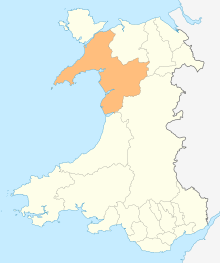Dinas Mawddwy
Dinas Mawddwy (![]()
Dinas Mawddwy
| |
|---|---|
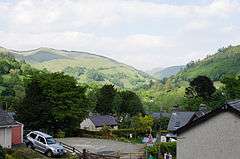 A view across the village of Dinas Mawddwy | |
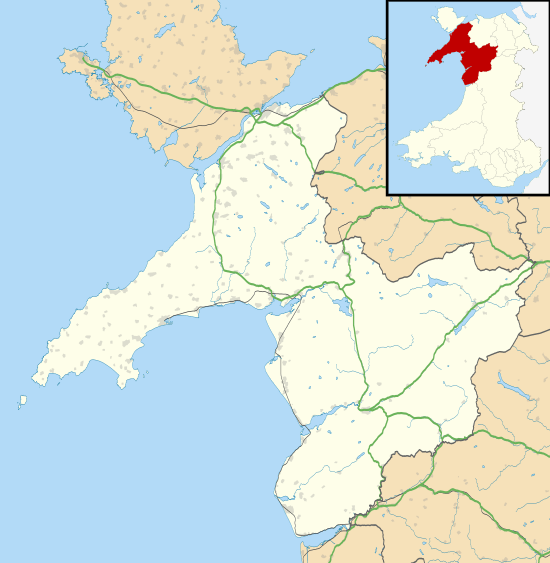 Dinas Mawddwy Location within Gwynedd | |
| Population | 622 (2011) |
| OS grid reference | SH857148 |
| Community | |
| Principal area | |
| Country | Wales |
| Sovereign state | United Kingdom |
| Post town | MACHYNLLETH |
| Postcode district | SY20 |
| Dialling code | 01650 |
| Police | North Wales |
| Fire | North Wales |
| Ambulance | Welsh |
| UK Parliament | |
| Senedd Cymru – Welsh Parliament |
|
Dinas Mawddwy is the home of the 1996 British Rally Championship winner Gwyndaf Evans and his son Elfyn Evans, winner of both Wales WRC Rally GB 2017 and Swedish WRC Rally 2020.[3]
Geography
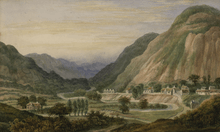
Dinas Mawddwy stands at the confluence of three rivers. The Afon Cywarch flows from the mountains to the north and the Afon Cerist flows from the west, both joining the River Dyfi here. The Dyfi flows south to Cemmaes Road where it turns west to head past Machynlleth to the Irish Sea. The mountains to the north are the Aran Fawddwy range of high, rocky peaks. To the south and the west stand the Dyfi Hills, dominated by Maesglase 3 miles (4.8 km) west of the town. Dinas Mawddwy itself is dominated by Foel Dinas which looms high over the west side of the valley.
Early history
Iron Age
There are thought to be two Iron Age fortifications in the immediate vicinity of Dinas Mawddwy. One is on the top of Moel Benddin, where a low depression forms the supposed site. The second fortification was in C'aer-bryn field, to the south of the Buckley Arms Hotel, that still had stonework in place in the late 18th century.[1]
Medieval period
The Ancient borough of Mawddwy was the only remaining part of the Kingdom of Powys still ruled by members of the native "royal family" (of Powys Wenwynwyn) after 1309. On the division of the realm in 1293, Mawddwy had been awarded to William de la Pole (of Mawddwy) and his descendants. The ruling family in Mawddwy would expire in the male line in 1414.
Dinas Mawddwy was the seat of the borough of Mawddwy and received its charter in 1394;[4] it retained that status until 1886. The Mayor of Mawddwy had the power to try offenders within the borough and punish them in the stocks, and to grant licenses to public houses, although this latter power ended in 1872.[1]
The Red Bandits of Mawddwy
In the 16th century, the Mawddwy area was home to a band of highway robbers and bandits named the ‘Gwylliaid Cochion Mawddwy’ or ‘Gwylliaid y Dugoed’. The Gwylliaid were supposedly the dregs of society, who came to the Dinas Mawddwy area having been excommunicated from their own areas. Some were hanged and others were exiled from the area forever. Two brothers pleaded to be pardoned by the Baron Owain, and his rejection of the plea enraged the Gwylliaid. They were intent on revenge and one night, while the Baron travelled home from Montgomeryshire, the Gwylliaid set traps on the road and shot arrows at the baron and his company. His body was found with thirty arrows attached to it.[5]
Transport
The village was served by the standard gauge Mawddwy Railway which connected with the Cambrian Railways at Cemmes Road railway station. Dinas Mawddwy was the northern terminus of the railway, which was built to serve the slate quarries at Minllyn and Aberangell and to provide passenger services along the upper Dyfi valley. The railway opened in 1867 and ran passenger services until 1 January 1931.[6] It closed completely in September 1950 after heavy flooding of the River Dyfi damaged the railway bridge north of Cemmes Road railway station. The line was officially closed on 1 July 1951.[7] The track was lifted early in 1952.[8]
Between 1975 and 1977, the 2 ft (610 mm) gauge Meirion Mill Railway ran from Meirion Mill on the site of Dinas Mawddwy station for about a mile south towards Aberangell.[9]
Lords of Mawddwy
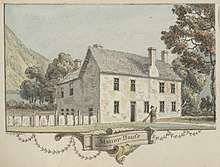
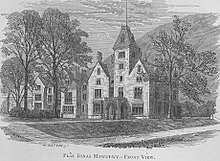
From around 1500, the Lordship of Mawddwy was held by members of the Mytton family.[10] In 1734, John Mytton, then the Lord of Mawddwy, donated a black marble font to the church at Mallwyd. The family held the lordship until 1831, when it was sold by "Mad Jack" Mytton to John Bird. In 1856. Bird in turn sold the title and the substantial estate in and around Dinas Mawddwy to Sir Edmund Buckley, a rich industrialist from Ardwick near Manchester.[11] Buckley passed the title and estate to his son Sir Edmund Buckley, 1st Baronet in 1864. In turn they passed to Sir Edmund Buckley, 2nd Baronet in 1910. The youngest Sir Edmund died fighting at Gallipoli in 1919.
The Lord of Mawddwy was empowered to hold a Court leet. This medieval judicial system continued in active use as late as 1914.[12] In 1891 the following notice of the twice annual court was posted in Dolgellau:
- NOTICE is HEREBY GIVEN that the COURT LEET Court Baron and View of Frankpledge of and for the above Manor and for the City and Borough of Dinas Mawddwy for Michaelmas 1891 will be held at the Buckley Arms Hotel Dinas Mawddwy on Thursday the 19th day of November next at One o clock in the Afternoon where and when all Jurors Constables Homagers and others who owe suit and service are required to attend WR DAVIES, Dolgelley, Oct. 31st 1891[1]
References
- Ashton, Charles (1892). A Guide to Dinas Mawddwy. Machynlleth: J. J. Gibson.
- Phillips, Richard (1810). Collection of Modern and Contemporary Voyages and Travels, Volume 1. R. Phillips.
- Parri, Ian. Placid haven with a wicked secret Liverpool Daily Post, 24 Jan 2005
- J. Beverley Smith, Llinos Beverley Smith (1 November 2001). History of Merioneth II: The Middle Ages. University of Wales Press.CS1 maint: uses authors parameter (link)
- "Gwylliaid Cochion Mawddwy ('The Red Bandits of Mawddwy')". Snowdonia National Park. Archived from the original on 23 October 2013. Retrieved 18 November 2012.
- "Railways to Close". Belfast News-Letter. 15 December 1930.
- Passengers No More by G.Daniels and L.Dench first edition page 41
- Cozens, Lewis; Kidner, R.W.; Poole, Brian (2004). The Mawddwy, Van & Kerry Branches. The Oakwood Press. pp. 44–47. ISBN 0853616264.
- Quine, Dan (November 2016). "Trixie and the Meirion Mill Railway". Narrow Gauge World.
- Bindoff, S.T. (1982). Mytton, Richard (1500/1-91), of Shrewsbury and Halston, Salop and Dinas Mawddwy, Merion The History of Parliament: the House of Commons 1509-1558.
- "The Manor of Mawddwy". Cambrian News. July 1869.
- "Manor of Mawddwy". Cambrian News. 6 February 1914.
External links
| Wikimedia Commons has media related to Dinas Mawddwy. |
| Wikivoyage has a travel guide for Dinas Mawddwy. |
- www.geograph.co.uk : photos of Dinas Mawddwy and surrounding area
- "Dinas Mawddwy". Disused Stations: Closed Stations in the UK. Retrieved 18 November 2012.
